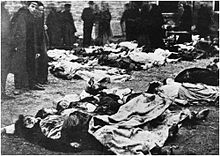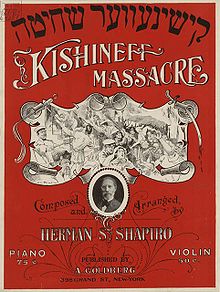47°02′15″N 28°48′16″E / 47.0376°N 28.8045°E
| Kishinev pogrom | |
|---|---|
| Part of the pogroms in the Russian Empire | |
 Bodies in the street | |
| Location | Kishinev, Bessarabia Governorate, Russian Empire (now Chișinău, Moldova) |
| Date | 19–21 April [O.S. 6–8 April] 1903 |
| Target | Bessarabian Jews |
Attack type | |
| Deaths | 49 |
| Injured | 92 gravely injured >500 lightly injured |
| Perpetrators | Russian pogromists |
| Motive | Antisemitism |

The Kishinev pogrom or Kishinev massacre was an anti-Jewish riot that took place in Kishinev (modern Chișinău, Moldova), then the capital of the Bessarabia Governorate in the Russian Empire, on 19–21 April [O.S. 6–8 April] 1903.[1] During the pogrom, which began on Easter Day, 49 Jews were killed, 92 were gravely injured, a number of Jewish women were raped, over 500 were lightly injured and 1,500 homes were damaged.[2][3] American Jews began large-scale organized financial help, and assisted in emigration.[4] The incident focused worldwide attention on the persecution of Jews within the Russian Empire,[5] and led Theodor Herzl to propose the Uganda Scheme as a temporary refuge for the Jews.[6]
A second pogrom erupted in the city in October 1905.[7]
- ^ Penkower, Monty Noam (October 2004). "The Kishinev Pogrom of 1903: A Turning Point in Jewish History". Modern Judaism. 24 (3). Oxford University Press: 187–225. doi:10.1093/mj/kjh017.
- ^ "The pogrom that transformed 20th century Jewry". The Harvard Gazette. 9 April 2009. Retrieved 26 March 2016.
- ^ Chicago Jewish Cafe (20 September 2018). "Are Jewish men cowards? Conversation with Prof. Steven J. Zipperstein". YouTube. Retrieved 8 October 2018.
- ^ Cite error: The named reference
:0was invoked but never defined (see the help page). - ^ Corydon Ireland (9 April 2009). "The pogrom that transformed 20th century Jewry". The Harvard Gazette.
- ^ Birnbaum, Erwin. In the Shadow of the Struggle. Accessed 27 January 2022.
- ^ Cite error: The named reference
JEncyclowas invoked but never defined (see the help page).